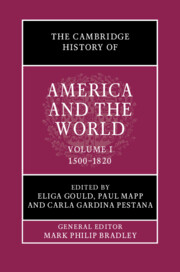Book contents
- The Cambridge History of America and the World
- The Cambridge History of America and the World
- The Cambridge History of America and the World
- Copyright page
- Contents
- Figures
- Maps
- Contributors to Volume I
- General Introduction: What is America and the World?
- Introduction: What Does America and the World “Mean” before 1825?
- Part I Geographies
- Part II People
- Part III Empires
- Part IV Circulation/Connections
- Part V Institutions
- 17 Slavery, Captivity, and the Slave Trade in Colonial North America’s Global Connections
- 18 A Maritime World
- 19 Antislavery in America, 1760–1820: Comparisons, Contours, Contexts
- 20 Women, Gender, Families, and States
- 21 Empires and the Boundaries of Religion
- Part VI Revolutions
- Index
19 - Antislavery in America, 1760–1820: Comparisons, Contours, Contexts
from Part V - Institutions
Published online by Cambridge University Press: 12 November 2021
- The Cambridge History of America and the World
- The Cambridge History of America and the World
- The Cambridge History of America and the World
- Copyright page
- Contents
- Figures
- Maps
- Contributors to Volume I
- General Introduction: What is America and the World?
- Introduction: What Does America and the World “Mean” before 1825?
- Part I Geographies
- Part II People
- Part III Empires
- Part IV Circulation/Connections
- Part V Institutions
- 17 Slavery, Captivity, and the Slave Trade in Colonial North America’s Global Connections
- 18 A Maritime World
- 19 Antislavery in America, 1760–1820: Comparisons, Contours, Contexts
- 20 Women, Gender, Families, and States
- 21 Empires and the Boundaries of Religion
- Part VI Revolutions
- Index
Summary
A broad perspective on the history of American antislavery in the revolutionary era might begin with the geographic and demographic conditions that first made the Atlantic slave trade and colonial slavery controversial. In the mid-eighteenth century, the thirteen colonies occupied the northern end of the long chain of plantation colonies that arced down the western shore of the Atlantic Ocean from the Chesapeake Bay to Rio de Janeiro. In North America, captured Africans and their descendants labored predominantly in the staple-producing colonies of Virginia, Maryland, South Carolina, and Georgia. Ninety percent lived either in the Chesapeake or the Lowcountry. Those 500,000 captives, though, represented just a tenth of the enslaved population of the Americas in 1760. The beating heart of the plantation complex lay in the Caribbean where 3 to 4 million toiled, predominantly on sugar plantations. Further south, Brazil contained perhaps one-and-a-half million Africans, roughly three times the number who resided in the thirteen colonies that declared independence from Britain in 1776. The provinces that formed the new American republic, therefore, sat at the margins of this system.
- Type
- Chapter
- Information
- The Cambridge History of America and the World , pp. 423 - 441Publisher: Cambridge University PressPrint publication year: 2022

